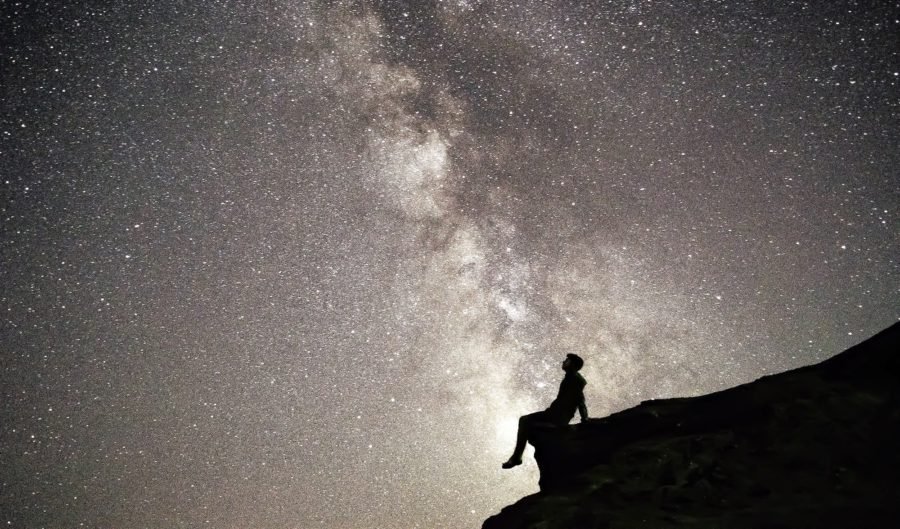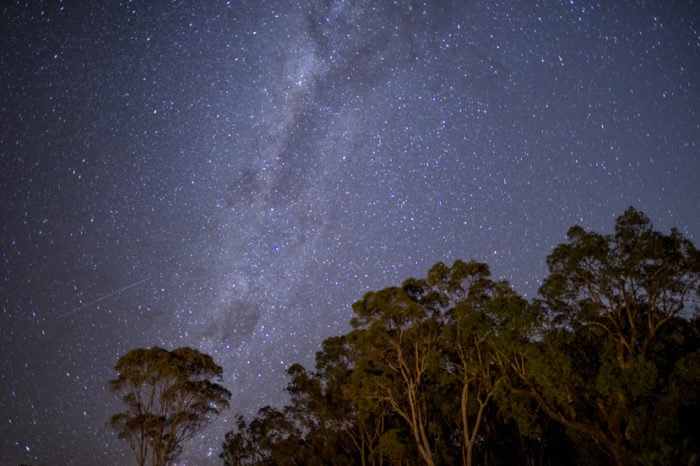Why we need to reconnect with the night sky

ASTROPHYSICIST Lisa Harvey-Smith has been campaigning against light pollution since she was 13 years old. Having grown up in a small village 60km from London, she’d had the privilege of staring into the night sky, devoid of any light pollution – perfect for her astrophotography.
That was until a leisure centre moved in close by and installed a huge spotlight and flood lights, which shone across the horizon where she’d previously stargazed. Unwilling to sit back and let this happen, she wrote to her local council.
“I was quite the precocious teenager,” Lisa tells Australian Geographic. “I wrote this letter and to my surprise the council engaged with me quite strongly… I had meetings with all these men in suits and I was sitting there telling them about how they could provide energy efficient lights that don’t shine up into the sky.”
Today, Lisa Harvey-Smith is one of Australia’s most decorated astrophysicists. Her new book When Galaxies Collide was released in July 2018 and received praise from the likes of Brian Cox, and other big-wigs in the world of astronomy, who admire the way it smoothly guides readers – whether astronomy fanatics or first-timers – through the galaxies. But the book also serves as a warning.
Dark-sky: a wilderness that needs protecting
Lisa says that the first step in protecting the night sky is understanding that it’s a natural habitat like any other. “If you lose bushland you lose vital habitat, if you lose flowers you lose bees, which we rely on. When you lose the night sky you lose something that teaches us that we’re a part of something bigger than ourselves.”
The International Dark-Sky Association was founded in 1988 for the purpose of raising awareness around light pollution and advocating ‘dark-sky parks’, of which Australia has just one – the Warrumbungle National Park in central-west New South Wales. However, there used to be more.
“Through the ages we’ve built telescopes and observatories further and further from cities but every time we build a great observatory, lights go up nearby. Mount Stromlo in Canberra is a good example of this happening,” Lisa says.
“It used to be a remote dark-sky, but now there’s a big housing estate right next to it. And of course, that’s progress, because humans have to live somewhere, but we’re kind of chasing the darkness and astronomy is getting pushed out.”

The Milky Way from Warrumbungle National Park. (Image credit: Bill Hatcher)
Energy-efficient, focussed lighting needed
Advocating for energy-efficient, focussed lighting has followed Lisa well beyond her teenage years. “Every photon and particle that comes from a light should be shining in the right direction. There’s no benefit to a light that shines upwards or scattered. It’s pollution and a total waste of taxpayer money,” she says.
“We don’t want to switch off all the lights and make it unsafe for people to walk and drive around cities, rather I’d like to see shielded lights that shine downwards, like they do in many places around the world. There are designs available to us, it isn’t rocket science. If people get behind campaigns to actually create good lighting in public spaces, we’d all be better off.”
According to an academic paper published in Science Advances in 2016, more than one-third of humanity can’t see the Milky Way, and this includes 60 per cent of Europeans and nearly 80 per cent of North Americans. “When we lose the night sky we lose touch of who we are, our ancestors and cultures. It’s such a shame that so few can see the Milky Way. We are truly built to look up and wonder. Looking up to the sky is unique to humans, and without that we’re losing something fundamental to ourselves.”
The ‘Golden Age’ of astronomy
Much of Lisa’s book discusses what could happen to the night sky when Earth’s galaxies collide with the Andromeda galaxy (hence the title of her book) in 3.8 billion years’ time, when she predicts that the study of astronomy may be made impossible.
“If you zoom out and think about the whole history of the universe and the potentially huge future that we have too, it’s easy to see why right now is considered the golden age of astronomy.
“We live on this beautiful planet, which is orbiting a stable star, the conditions are perfect for us to live here, and also we have a beautiful night sky because it has wonderful shades of dark and light and we can see right through to the early stages of the universe, we have a horizon through which we can see the Milky Way from where we live, and nothing is blocking our view.
“In the future, when our galaxies collide with the Andromeda galaxy, we may well have a night sky completely filled with light because so many new stars will form. There will be half a trillion stars shining in the night sky and it will be so bright that we may not even be able to do astronomy in the future.”
Stargazing, a way to bond
In the final chapter of her book, ‘Staying connected’, Lisa talks about stargazing rarely being a solitary activity, but a way to bond within a community and from generation to generation.
“Even though we might read about the stars in books, it’s always better when it’s passed down through the generations. My grandfather who loved astronomy showed my dad the stars at night and then my dad passed that down to me.
“It’s one of those family activities that doesn’t cost anything, you can just stand there with someone who means something to you. I think it’s a beautiful thing and it connects us through the ages.”
When Galaxies Collide by Lisa Harvey-Smith is published by Melbourne University Press.

